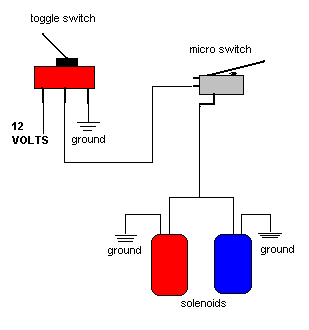Here's where I am now with my new Harris Speed Works dry kit...
I had installed the whole system by the book. At first, there was one minor problem; my relay was damaged. The plastic casing around the guts of the relay was cracked and fell apart so I carefully put it back together thinking it would be okay (mistake).
The micro WOT switch was mounted under the gas pedal with a zip tie in a manner I borrowed from this forum (thank you for the idea).
So I got the bottle filled (REMEMBER TO USE TEFLON TAPE OR PASTE WHEN YOU HOOK UP YoUR CONNECTIONS!!!!!!) and had it mounted between the back seats of my 2001 convertible. From there I could easily access the bottle valve. The thing is mounted to the carpet and seems very secure even during violent cornering.
When I finally got the chance to test the thing, I must have mashed my foot to the floor too hard as I jammed the switched into the ON position (no more clickety-click sound/feel). Luckily, the relay failed on me and the juice cut off before I had a chance to back off the accelerator. :banana: .
It was late at night and my bottle was only at 800 psi (remember this is a dry kit), but the kick in acceleration, however short lived, was very enjoyable.
This brings me back to the drawing board.
I picked up a custom arming switch plate from HSW and I have no micro WOT or working relay harness. I know it is potentially dangerous to use nitrous without the WOT switch, but can't a person just train themselves to deactivate the armed system before letting off the gas?
and I have no micro WOT or working relay harness. I know it is potentially dangerous to use nitrous without the WOT switch, but can't a person just train themselves to deactivate the armed system before letting off the gas?
I am thinking of wiring the system without the relay. I found an example of how this is done on the nitrousdirect website...

What I would do is to have the solenoid connected to ground in the engine bay, then have a power wire running through the arming switch plate and then into the engine bay to the solenoid. When the arming switch plate completes the current, the solenoid releases the nitrous.
The way I plan on setting up the switch plate is to have it so a switch has to be flipped before the push-button will be allowed to complete the current to the solenoid.
I think this will give me more direct control over the system. I can install another switch that will have to be activated for redundancy as I would not want anyone else to be playing with my nitrous setup.
Of course I still have to find out if the switch plate is going to be able to handle the juice required to work the solenoid...
How does this sound?
I had installed the whole system by the book. At first, there was one minor problem; my relay was damaged. The plastic casing around the guts of the relay was cracked and fell apart so I carefully put it back together thinking it would be okay (mistake).
The micro WOT switch was mounted under the gas pedal with a zip tie in a manner I borrowed from this forum (thank you for the idea).
So I got the bottle filled (REMEMBER TO USE TEFLON TAPE OR PASTE WHEN YOU HOOK UP YoUR CONNECTIONS!!!!!!) and had it mounted between the back seats of my 2001 convertible. From there I could easily access the bottle valve. The thing is mounted to the carpet and seems very secure even during violent cornering.
When I finally got the chance to test the thing, I must have mashed my foot to the floor too hard as I jammed the switched into the ON position (no more clickety-click sound/feel). Luckily, the relay failed on me and the juice cut off before I had a chance to back off the accelerator. :banana: .
It was late at night and my bottle was only at 800 psi (remember this is a dry kit), but the kick in acceleration, however short lived, was very enjoyable.
This brings me back to the drawing board.
I picked up a custom arming switch plate from HSW
I am thinking of wiring the system without the relay. I found an example of how this is done on the nitrousdirect website...

What I would do is to have the solenoid connected to ground in the engine bay, then have a power wire running through the arming switch plate and then into the engine bay to the solenoid. When the arming switch plate completes the current, the solenoid releases the nitrous.
The way I plan on setting up the switch plate is to have it so a switch has to be flipped before the push-button will be allowed to complete the current to the solenoid.
I think this will give me more direct control over the system. I can install another switch that will have to be activated for redundancy as I would not want anyone else to be playing with my nitrous setup.
Of course I still have to find out if the switch plate is going to be able to handle the juice required to work the solenoid...
How does this sound?







Comment